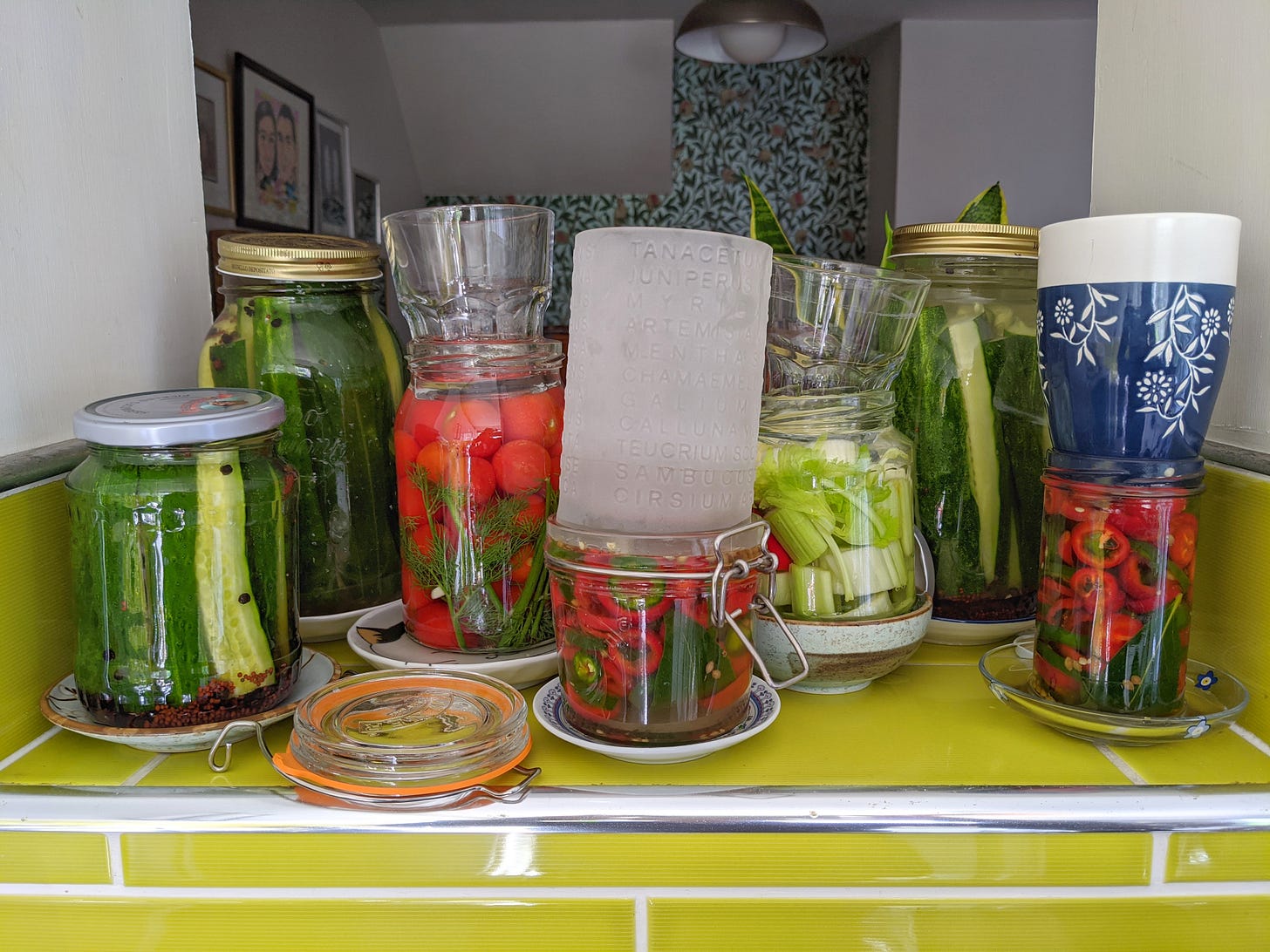How to ferment (pickle) any vegetable
And why you'd want to. Full of flavour & probiotics - you need just 3 things
This essay is part of the You Can Do This series where I share empowering and practical how to guides that will hopefully help you acquire a new lifelong skill.
Hi! This is Leyla from A Day Well Spent, a newsletter seeking pathways to more purposeful living.
What subscribers received recently:
I was recently asked to define my ‘style’ — it made me think about what having style means to me. This is what I came up with (with 📸)
This is Europe’s best kept festival secret — food, music, culture and unlimited wine samples - for just €10
15 quickfire questions with climate economist and wind chaser Catherine Chong
You can subscribe with your email to ensure you never miss my posts:
How to ferment (pickle) any vegetable
I’ve previously written a guide on how to make kefir (I’m pleased to report many readers are now making daily kefir as a result of this guide, including my Dad and brother!).
And today I’m sharing a guide on how to ferment any vegetable to make exceedingly tasty and crunchy pickles, that are also full of beneficial bacteria your microbiome will love.
The process of fermenting a vegetable is extremely simple.
You chop up the vegetable, put it in a jar, cover it with brine, weigh the veg down so it all stays submerged (I use a glass tumbler), wait two weeks and ta daa - you have delicious fermented pickles.
But of course, there’s a bit more to it than that.
In today’s column I share a step-by-step guide. And I’ve even included a video so you can watch me doing it too 🎥
You need just three things to start fermenting. A glass jar, sea salt and digital scales. If you have these — and a vegetable — you can get fermenting today.
I eat a few fermented vegetables alongside my meals on a daily basis and I have several jars of homemade pickles on the go at any one time!
In this guide I cover
Why should fermented foods feature in your diet?
What does ‘pickling’ mean and how does it work?
Vinegar pickling vs. lacto-fermentation (brine pickling) – what’s the difference?
How can we tell what process has been used when buying readymade pickles?
What vegetables can you lacto-ferment?
How to lacto-ferment any vegetable — nothing fancy required! (with 🎥)
What to do with the leftover brine once you’ve eaten all the pickles
How to store lacto-fermented pickles
How to eat lacto-fermented pickles
6 key points to remember for successful lacto-fermentation
Two of my favourite fermentation recipe books
If you enjoy this piece please let me know by tapping the ❤️ at the top or bottom or by forwarding it on — thank you!
Why should fermented foods feature in your diet?
It will come as no surprise to regular readers that I’m a big fan of fermented foods.
This is partly because some of the greatest foodstuffs in the world (when made using traditional methods) happen to be examples of fermented foods: cheese, wine, bread, kimchi, yoghurt, chocolate and coffee are all made by processes of fermentation.
In other words, fermented foods taste great. That’s good enough reason alone to regularly consume them.
But fermented foods can also be full of beneficial bacteria
And its these critters that help to keep your gut microbiome (the term given to the community of tiny organisms that live inside our gut) happy and healthy.
There have been whole books written about what a healthy microbiome means for our physical and mental health and wellbeing — I’ve read many of them.
Needless to say, a healthy microbiome is now understood to be one of the key pillars of good health.
If you’re interested in some extra reading, one of the most recently published books I have enjoyed on this topic is Genius Gut: The Life-Changing Science of Eating for Your Second Brain by
.Did you know 70% of our immune defences lie in our gut?
The first time I read this I was like, waaaat?!
The statistic blew my mind. And it’s something science has only understood in more recent times.
So if you are someone who gets sick a lot, suffers from various ailments or often feels run down, it could be because your gut is unhappy. And the happiness of your gut is largely dependent on what you put into it i.e. what you eat.
I write more about this in How to not catch a cold (note: my current streak is one cold in two years and it came and completely cleared in about 36 hours).
Fermentation is a great way to preserve the abundance and flavours of summer
Which is ideal for seeing us through the colder months.
And as we head into root vegetable season (some of the best of all the vegetables to ferment), the process of fermentation has the magical power to transform something as humble as a carrot or turnip into a gastronomic sensation, bursting with the most bright and brilliant flavours.
If you’ve ever eaten something and thought, ‘but why does this taste so good..?’, it’s probably because it contained a fermented food.
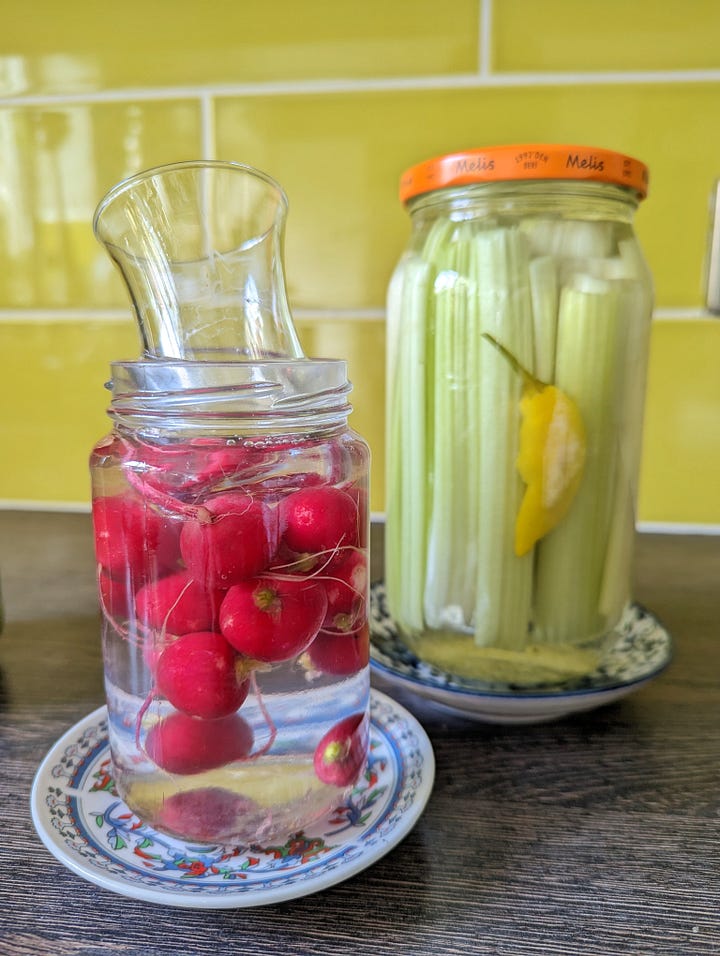
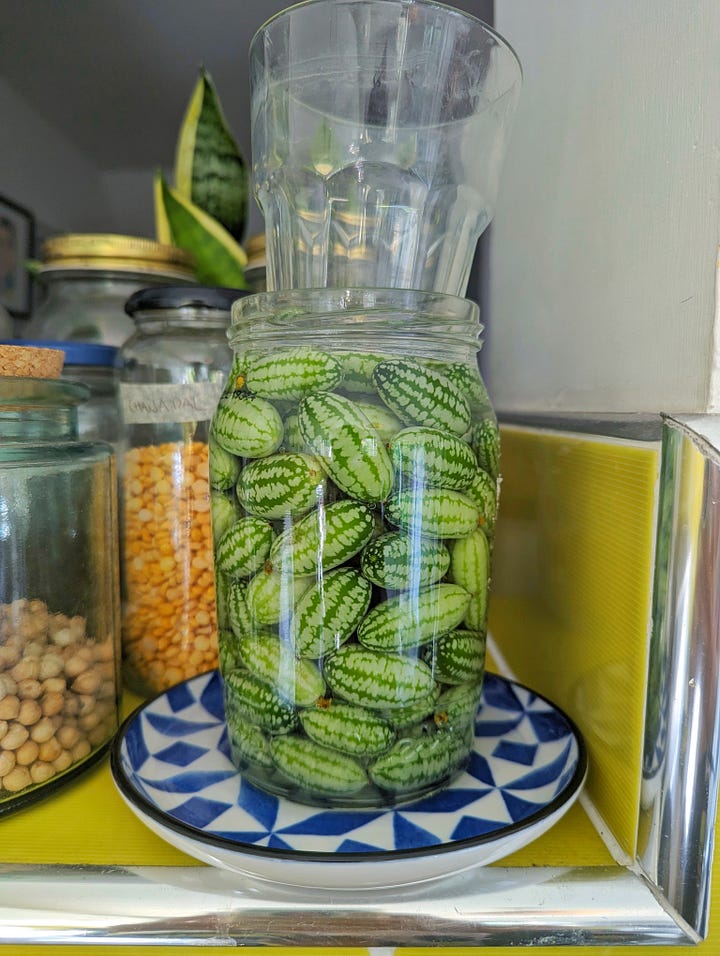
What does ‘pickling’ mean and how does it work?
Pickling is a process of food preservation that involves storing the food in an acidic environment that is too hostile for bad bacteria to grow.
The two most common ways to pickle food are:
in vinegar
in a salty brine
If you do the latter, the food will also ferment. And when you ferment something with salt and in the absence of oxygen, it is called lacto-fermentation.
Each of these two processes end up creating an acidic environment, resulting in sour pickles.
In the case of lacto-fermented pickles made using the salty brine, beneficial bacteria eat the sugars in the vegetables over the course of several days — this is the process of fermentation.
The outputs of this feasting are carbon dioxide and lactic acid (that’s where the lacto- comes from — it has nothing to do with lactose found in dairy).
The good bacteria continue to feed on the sugars and multiply. And the lactic acid they produce turns the saltwater into an acidic solution which is what prevents any bad bacteria from growing, thereby preserving the vegetable.
For vinegar pickles, you just pop the vegetables in vinegar, sometimes with sugar and / or salt and wait a bit. And sometimes this process involves heating the vinegar too.
Vinegar pickling vs. lacto-fermentation (brine pickling) – what’s the difference?
There are three main differences between vegetables that have been pickled via the process of lacto-fermentation, and vegetables that have been pickled in vinegar.
Probiotics
The first is the presence of probiotics, the fancy name for the bacteria that are beneficial for our guts, mentioned above.
Vegetables that have been fermented will be full of probiotics. Vegetables that have been pickled in vinegar will contain almost none.
Flavour
If a vegetable has been lacto-fermented, the process will develop an incredible, unique, complex and zingy flavour of the vegetable. Because fermentation is a natural process, batches can vary and flavours continue to develop over time.
This is partly what makes eating fermented foods so exciting and downright delicious.
Vegetables that have been pickled in vinegar taste like… vinegar-soaked vegetables. I’m not saying this is bad. The flavour just cannot compare to those of fermented vegetables, in my opinion.
Heat treatment
Another key difference to note is that sealing vinegar pickles in a hot water bath is very common.
When we do this, we cook both the vegetables and the liquid. As a result, we can store these sealed jars at room temperature for a long time without them spoiling or the contents changing in any way.
Lacto-fermented pickles are not cooked, you are eating the vegetables raw. This means the good probiotics that develop during the fermentation process are preserved and end up inside you. These pickles can still be stored for long periods but at low temperatures, such as in the fridge.
How can we tell what process has been used when buying readymade pickles?
If you are unsure if the pickles / kimchi / kraut etc. you are buying from a shop are lacto-fermented or have been pickled with vinegar, look for the following:
Which aisle is it in?
If it’s in the fridge aisle, it will likely be raw and lacto-fermented. If it’s in the ambient aisle, it’s been pickled with vinegar.
Check the ingredients
A jar of lacto-fermented vegetables should only contain water, salt and whatever vegetables / herbs etc. are being fermented. It should not contain any vinegar. If vinegar is listed, the vegetables have likely not been fermented.
Look for ‘pasteurised’
Sometimes a jar of pickles or sauerkraut will contain no vinegar (only vegetables, salt and water), yet you find it in the ambient aisle. If you look closely at the label, you’ll likely find the word ‘pasteurised’ somewhere.
This means the contents of the jar started off as being fermented, but then it was pasteurised to kill off any potential harmful bacteria, which of course kills off all the good bacteria too.
This leaves a jar of food with a probiotic value of zero.
There is absolutely nothing wrong with vegetables pickled in vinegar. But because of all the above benefits, I choose to always pickle my vegetables in saltwater so they ferment.
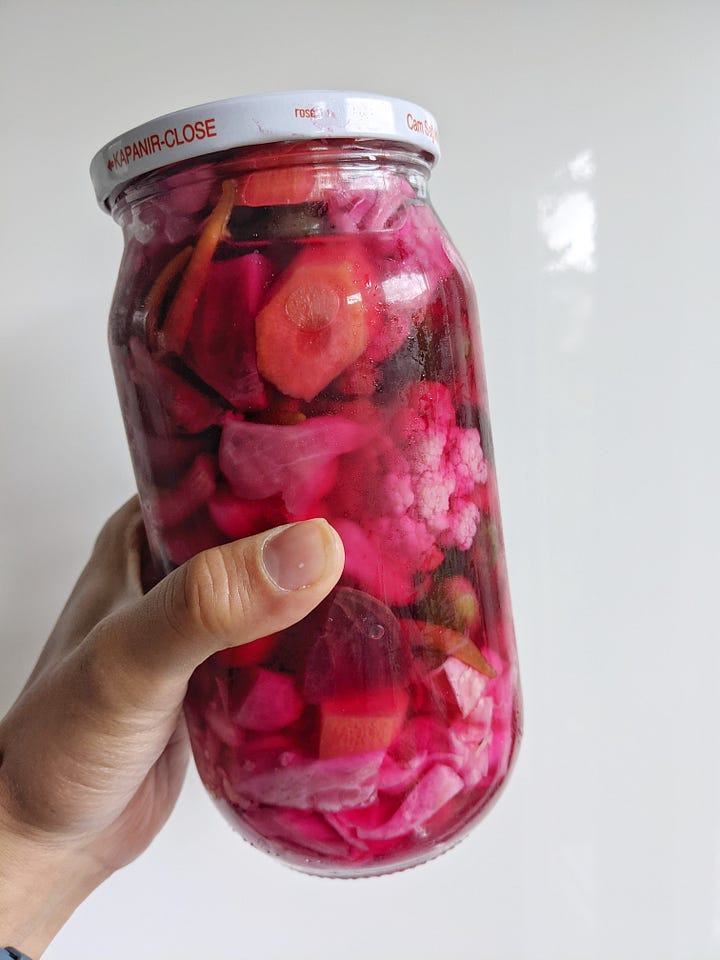
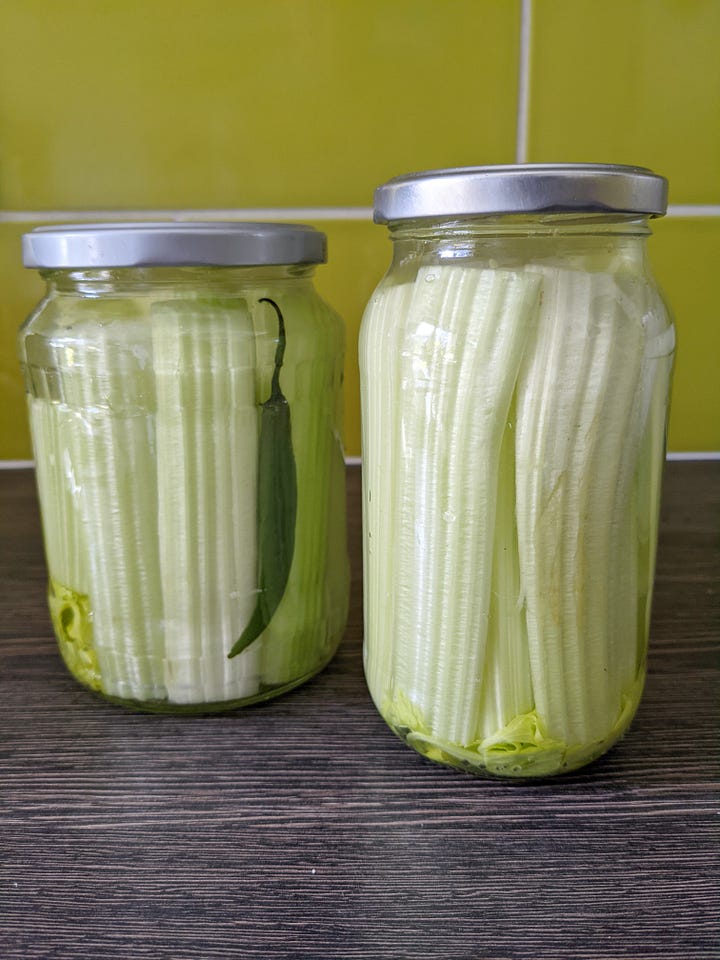
What vegetables can you lacto-ferment?
You can lacto-ferment pretty much any edible plant.
As well as your standard supermarket vegetables, I’ve also lacto-fermented some of my foraged wares including dandelion leaves, nettle leaves (I made a nettle “kimchi” which was ridiculously good) and sloes aka blackthorn, which become a bit like salty black olives!
From all the vegetables, crunchy ones work particularly well.
For example, any root vegetable you can eat raw (so not potatoes) are perfect for fermenting – carrots, kohlrabi, turnips, beetroot, parsnips, radishes.
Also broccoli, cauliflower, cherry tomatoes (avoid big ripe tomatoes, they’ll turn to mush), unripe green tomatoes, French and runner beans, celery, cucumbers, aubergines, cabbage, kale, courgettes, onions — the list goes on.
One of my absolute favourite vegetables to ferment is celeriac – I’m delighted if one turns up in my vegetable box for this reason. And chillies! Pickled chillies are the absolute bomb and taco nights are not the same without them.
You can also lacto-ferment fruit too which creates a great sweet, salty and sour combination. I’m currently fermenting some of my homegrown plums.
I think one of the best vegetables to start with are carrots.
Because a fermented carrot has a wonderful flavour and carrots are easy and cheap to come by. So if you happen to mess it up (which you won’t, if you follow this guide), it’s no big loss.
How to lacto-ferment any vegetable
You need no fancy equipment nor any prior knowledge or skill. This process is available to everyone. When people are told how to make homemade fermented pickles, they are always amazed at just how easy it is.
It could end up being another one of those instances where you say, ‘I’ve been spending how much on industrially produced probiotics / ferments, when I could have been making them myself in minutes..?’
A similar effect to when I shared the recipe to my breakfast for most of the year — ‘this is so easy and so much cheaper, why didn’t I start doing this sooner?!’
You may soon start looking at every vegetable that enters your kitchen as a potential ferment (if this happens to you, welcome – you have fully arrived).
Here’s everything you need to know about how to very easily ferment any vegetable to turn it into delicious pickles, full of flavour and probiotics. With a video too 🎥
What you need






